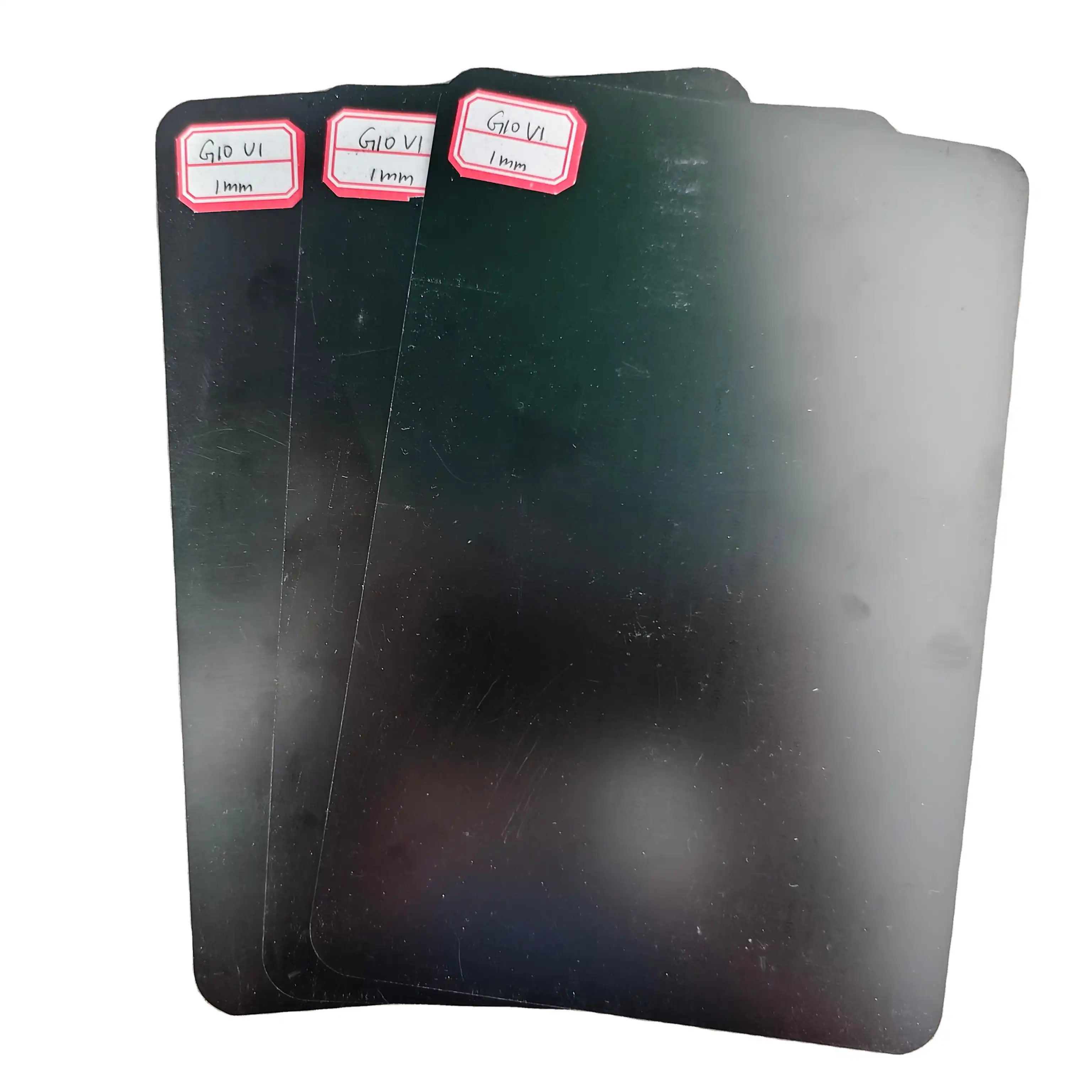Composition and Manufacturing Process of G10 Epoxy Sheets
Raw Materials and Their Properties
G10 epoxy sheets are crafted from a carefully selected combination of materials that contribute to their outstanding performance. The primary components include:
- Fiberglass: Continuous filament glass fibers provide the reinforcement structure, imparting strength and rigidity to the composite.
- Epoxy Resin: A high-grade thermosetting polymer that acts as the matrix, binding the fibers together and offering excellent chemical resistance.
- Additives: Various compounds may be incorporated to enhance specific properties such as flame retardancy or UV resistance.
The synergistic interaction between these materials results in a composite that surpasses the individual properties of its constituents. The fiberglass contributes to the mechanical strength and dimensional stability, while the epoxy resin ensures superior electrical insulation and moisture resistance.
Manufacturing Techniques
The production of G10 sheets involves a sophisticated manufacturing process that ensures consistent quality and performance. The key steps include:
- Prepreg Preparation: Glass fibers are impregnated with epoxy resin to create prepreg sheets.
- Layup: Multiple layers of prepreg are stacked in a specific orientation to achieve desired properties.
- Compression Molding: The layered stack is subjected to heat and pressure in a hydraulic press.
- Curing: A controlled curing cycle solidifies the epoxy resin, creating a homogeneous structure.
- Post-Processing: Sheets are trimmed, inspected, and may undergo additional treatments.
This meticulous process ensures that G10 sheets exhibit uniform properties throughout their structure, making them reliable for critical applications.
Quality Control Measures
Rigorous quality control is essential in the production of G10 epoxy sheets to maintain their superior properties. Manufacturers implement various measures:
- Raw Material Testing: Incoming materials are analyzed to verify composition and purity.
- In-Process Monitoring: Key parameters such as temperature, pressure, and cure time are closely monitored.
- Non-Destructive Testing: Techniques like ultrasonic inspection are used to detect internal defects.
- Mechanical Testing: Samples undergo tensile, flexural, and impact tests to ensure compliance with industry standards.
- Electrical Property Verification: Dielectric strength and insulation resistance are measured to confirm electrical performance.
These comprehensive quality control measures guarantee that G10 sheets consistently meet or exceed the stringent requirements of various industries.
Exceptional Properties of G10 Epoxy Sheets
Mechanical Strength and Durability
G10 epoxy sheets boast remarkable mechanical properties that make them ideal for structural applications:
- High Tensile Strength: G10 sheets exhibit excellent resistance to pulling forces, with typical values exceeding 300 MPa.
- Impressive Flexural Modulus: The material's ability to resist bending deformation is noteworthy, often surpassing 18 GPa.
- Superior Impact Resistance: G10 demonstrates exceptional toughness, absorbing impact energy without catastrophic failure.
- Low Creep: Under sustained loads, G10 sheets maintain their dimensional stability, resisting deformation over time.
- Wear Resistance: The composite structure provides excellent resistance to abrasion and erosion in demanding environments.
These mechanical attributes contribute to the longevity and reliability of components manufactured from G10 sheets, reducing maintenance requirements and extending service life.
Electrical Insulation Capabilities
The electrical properties of G10 epoxy sheets are particularly noteworthy:
- High Dielectric Strength: G10 can withstand strong electric fields without breakdown, typically exceeding 20 kV/mm.
- Low Dielectric Constant: The material exhibits minimal electrical energy storage, making it suitable for high-frequency applications.
- Excellent Volume Resistivity: G10 sheets effectively prevent current flow through the bulk of the material.
- Arc Resistance: The composite resists surface tracking and erosion caused by electrical arcing.
- Stable Electrical Properties: G10 maintains its insulating characteristics across a wide range of temperatures and humidity levels.
These electrical properties make G10 an indispensable material in the design of electrical and electronic components, particularly in high-voltage and high-frequency applications.
Thermal and Chemical Resistance
G10 epoxy sheets excel in challenging environmental conditions:
- Thermal Stability: The material retains its properties over a wide temperature range, typically from -55°C to 130°C.
- Low Thermal Expansion: G10 exhibits minimal dimensional changes with temperature fluctuations, ensuring precise fit in assemblies.
- Flame Retardancy: Many G10 formulations offer inherent flame-resistant properties, enhancing safety in electrical applications.
- Chemical Inertness: The epoxy matrix provides resistance to a broad spectrum of chemicals, including acids, solvents, and oils.
- Moisture Resistance: G10 sheets have low water absorption, maintaining their properties in humid environments.
These characteristics enable G10 to perform reliably in harsh industrial settings, aerospace applications, and marine environments where exposure to extreme conditions is common.
Applications and Innovations in G10 Epoxy Sheet Utilization
Electrical and Electronic Applications
G10 epoxy sheets have become indispensable in the electrical and electronic industries:
- Circuit Boards: G10 serves as a substrate for printed circuit boards, providing a stable platform for electronic components.
- Transformer Components: Insulating parts in transformers benefit from G10's excellent dielectric properties and dimensional stability.
- Switchgear: Arc-resistant G10 components enhance the safety and reliability of high-voltage switchgear.
- Motor Insulation: The material's thermal and electrical properties make it ideal for motor winding insulation and slot liners.
- Antenna Radomes: G10's low dielectric constant and weather resistance are advantageous in protecting radar and communication antennas.
The versatility of G10 sheets in electrical applications continues to drive innovation in product design and performance enhancement.
Mechanical and Structural Uses
The exceptional mechanical properties of G10 epoxy sheets find applications in various structural components:
- Aerospace Components: Lightweight G10 parts contribute to fuel efficiency in aircraft and spacecraft structures.
- Precision Machined Parts: The material's stability allows for the creation of high-tolerance components for industrial machinery.
- Automotive Components: G10 is used in underhood applications where heat resistance and dimensional stability are crucial.
- Marine Applications: Corrosion-resistant G10 parts are ideal for boat construction and offshore equipment.
- Sports Equipment: The high strength-to-weight ratio of G10 is leveraged in the design of performance-enhancing sporting goods.
These applications showcase the material's ability to meet diverse mechanical requirements across multiple industries.
Emerging Applications and Future Trends
The ongoing research and development in G10 epoxy sheets are opening new avenues for application:
- 3D Printing: Advanced manufacturing techniques are enabling the creation of complex G10 structures with optimized properties.
- Nanotechnology Integration: Incorporation of nanoparticles into G10 composites is enhancing specific properties for specialized applications.
- Biomedical Devices: The biocompatibility of certain G10 formulations is being explored for medical implants and prosthetics.
- Energy Storage: G10's insulating properties are being utilized in the development of next-generation battery and capacitor technologies.
- Smart Materials: Integration of sensors and actuators within G10 laminates is paving the way for self-monitoring composite structures.
These emerging applications highlight the ongoing evolution of G10 epoxy sheets, demonstrating their potential to address future technological challenges.
Conclusion
G10 epoxy sheets stand at the forefront of functional composite materials, offering a unique combination of mechanical strength, electrical insulation, and environmental resistance. Their versatility in applications ranging from electrical components to structural elements underscores their significance in modern engineering. As research continues to unlock new possibilities, G10 sheets are poised to play an increasingly vital role in addressing the complex challenges of various industries. The superior properties of G10 epoxy sheets not only meet current demands but also pave the way for future innovations, solidifying their position as a cornerstone material in the realm of high-performance composites.
Contact Us
To explore how G10 epoxy sheets can elevate your projects and learn more about our extensive experience in producing and supplying high-quality insulating materials, we invite you to contact us. Our team of experts is ready to provide personalized solutions tailored to your specific needs. Reach out to us at info@jhd-material.com and discover the transformative potential of G10 epoxy sheets for your applications.






